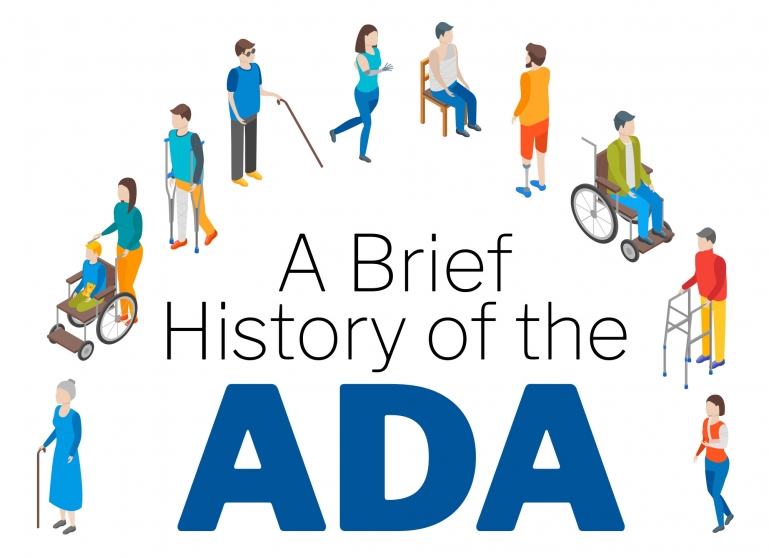Celebrating 32 years of the Signing of the Americans with Disabilities Act (ADA)

Celebrating 32 years of the Signing of the Americans with Disabilities Act (ADA)
July 26, 2022, marks 32 years since the signing of the Americans with Disabilities Act (ADA). The ADA was signed into law to ensure people with disabilities have the same rights and opportunities as everyone else. We’ve come a long way since before the signing of the ADA, but DRC and the disability community continue to fight for the rights of individuals with disabilities. DRC values all forms of diversity, and we are committed to a culture of belonging where all people are welcome.
Today, we understand that disability rights are part of a broader fight for justice including the unique challenges faced by people who experience the intersection of multiple systems of discrimination. It’s important we recognize these intersectional identities and everyone’s inherent right to freedom, independence, and self-determination.
We celebrate this landmark bill and encourage all of us to reflect on what the ADA means to us and what efforts are still needed for civil rights and equality for all.
As we celebrate this landmark civil rights bill, it’s important to also remember what life was like before the ADA, and why there is still so much for keep fighting for!
Many Americans don’t remember what it was like for people with disabilities before the signing of the ADA. After all, as of July 26, the ADA has been the law of the land for 32 years! Many people simply weren’t alive at a time before the ADA, so it can be easy to take for granted all the protections that the ADA gives people with disabilities.
Some improvements made from the ADA Include:
Employment & Reasonable Accommodations
Before the ADA, there weren’t any laws set in place that made discrimination based on disability illegal. Therefore, employers could ask if you had a disability, and if you answered “yes,” they could decide they didn’t want to hire you because of that disability. This type of employment discrimination is now illegal.
Today, the ADA prohibits disability-based discrimination by private employers. Discrimination includes unequal treatment, retaliation and harassment against employees and job applicants with disabilities.
It also includes the failure to provide reasonable modifications to an employer’s practices, policies, or workplace conditions in order to accommodate an employee’s or applicant’s disability.
Transportation & Accommodations
Before the ADA there were not as many accessible options for public structures and transportation, and individuals were often denied freedom of movement and independence. Libraries, schools, courtrooms, transportation, and other resources were available to the public but not accessible to the millions of disabled people.
Today, the ADA defines discrimination as the exclusion, segregation, and unequal treatment of people with disabilities in public accommodations. Now, the ADA encourages businesses to provide ramps for wheelchairs, accommodations, better accessible options for public transportation, ride-sharing services, and much more.
There have also been improvements in accessibility in communication access, regulations for service animals, and so much more. We mark this month to celebrate and remember how far we’ve come.

May 4, 1977
Section 504 regulations were issued, which formed the basis of the ADA. Section 504 regulations were established, recognizing the economic status of people with disabilities was not due to the disability itself, but was instead due to prejudices and barriers.
1986
The National Council on Disability issued a report, Toward Independence, which recommended comprehensive civil rights legislation, leading the way for the ADA.
1990
After much work, various drafts of legislation, and overcoming significant opposition from various groups – including religious and business interests – Senator Tom Harkin authored the final bill.
On July 26, 1990, President George H. W. Bush signed the ADA into law, stating “Let the shameful wall of exclusion finally come tumbling down.”
1999
The Olmstead Act, or Olmstead v. LC Supreme Court decision, was based on the Americans with Disabilities Act. The Supreme Court held that people with disabilities have a qualified right to receive state funded supports and services in the community rather than institutions. For more information, visit https://www.olmsteadrights.org/.
2008
The ADA Amendments Act of 2008 was signed into law by President George W. Bush. These amendments broadened the meaning of the term “disability” so that the ADA could be used to offer civil rights protections to more people.

Other Resources:
Learn more about the history of the ADA, and what life was like before its passage, with these resources:
- 8 ways in which the Americans with Disabilities Act changed everyone's lives
- Reflecting on Life Before the Americans with Disabilities Act
- How the Americans with Disabilities Act transformed a country
- The ADA at 30: Looking Back and Ahead

Let’s Celebrate & Continue the Conversations on Disability Justice for all!
The passage of the ADA 32 years ago is cause for celebration! Besides learning more about the history of the ADA, here are some ways we can celebrate this bill which has improved the lives of so many.
For Individuals:
Know your rights!
Get to know your rights and the rights of your friends, family members, and community members who live with disabilities by checking out DRC’s Self-Advocacy Resources.
Learn more from one of DRC’s free webinars discussing various disability topics: https://www.disabilityrightsca.org/events
Spread the word on Social Media!
Tag us in a social media post and use the hashtags #ThanksToTheADA and #ADA32:
- Facebook: @DisabilityRightsCalifornia
- Twitter: @DisabilityCA
- Instagram: @DisabilityRightsCA
- LinkedIn: @Disability-Rights-California
Share why you’re thankful for the ADA! Share a moment in your life when you were thankful for the ADA, and/or how we as a community can continue the conversations on equality and civil rights.
Keep the fight for intersectional civil rights going!
Learn about being an LGBTQIA+ ally and get tips on how to be anti-racist to make sure that our broader fight for disability rights is inclusive of people who may have intersectional identities.
For Business:
Review Diversity & Inclusion Statements/Mission: Take a look at how you talk about disability in your workplace. Think about inclusivity of all.
Review the Diversity Page on your Website: Review your webpage and assess how you talk about people with disabilities. Do you feature employees with disabilities in comments, or videos?




